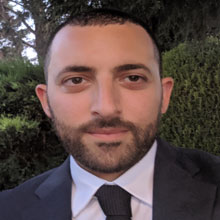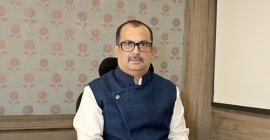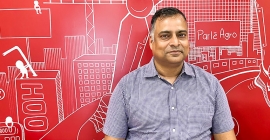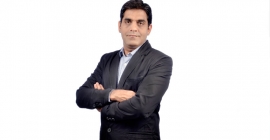‘DOOH is enhancing advertisers’ perception of OOH’
By Rajiv Raghunath - December 09, 2019
Jonathan Conway, Chief Strategy Officer, Talon elaborates on the new growth avenues that are opening for OOH across markets
 As CY2019 draws to a close, how would you view the year from the global OOH industry perspective?
As CY2019 draws to a close, how would you view the year from the global OOH industry perspective?
2019 has been an eventful year in OOH. We’ve seen continued consolidation and digitisation and, on the advertiser side, a growing appreciation of the powerful and varied roles that OOH can play to drive brand and business outcomes.
These dynamics are why OOH continues to grow at an impressive rate in comparison to other ‘traditional’ channels. Global OOH ad spend is forecasted to grow by 8.5% in 2020 (PQ Media) with demand for OOH advertising increasing in both emerging and mature markets like the UK and US, with the latter now enjoying its highest rate of growth since 2007 (OAAA).
Advertisers’ perceptions of OOH are improving because digital OOH has upgraded the quality and performance of the channel. This is thanks to the heavy investment in digital display networks and ad technologies by OOH buyers and sellers, which is making it easier for advertisers to capitalise on the superior impact and effectiveness that digital OOH delivers.
Digital OOH posted the highest increases across all formats and will account for 28.3% of overall global OOH revenues by the end of 2019. At Talon, well over 50% of our UK ad spend is now dedicated to digital.
What could be the likely OOH growth catalysts in CY2020?
Looking ahead to 2020, it feels like the OOH industry is at somewhat of a crossroads. Rapid digital OOH growth creates many benefits, but has also brought with it growing executional complexity. The way the medium is being planned, transacted and reported is gradually becoming more automated, and will eventually make OOH look and feel a lot more like online digital channels. But the reality is that there is still a long way to go to automate business processes at scale, especially at a global level.
Getting automation right is critical if the industry is to achieve the exponential growth that we all know is possible in the medium term. We need to free up our OOH experts so they can spend more time selling the medium and creating more strategic, innovative and effective work.
The other major catalyst for growth is in classic OOH, which is seeing a renaissance in creativity, as many advertisers recognise the power of dominating a permanent space with a simple, unmissable, impactful presence. Some of the most effective work in this space has been done by ‘online’ brands such as Spotify, Apple and Google. They all understand the importance of delivering a clear and bold statement about their brands in the real world.
Do you see a key role for OOH in a brand’s omni-channel marketing strategy?
OOH can play many roles in a brand’s marketing strategy. Traditionally, OOH was seen as a broadcast, brand-building channel. Today, its remit is much bigger. Digitisation, data innovation, precise targeting, and dynamic creative deployment, have combined to create new opportunities for brands using OOH.
DOOH can play a big part in the broader digital conversation, driving search and amplifying social conversations and extending online video strategies.
Video has become an essential tool for advertisers and can now be extended quite easily into DOOH. Video ads on platforms such as Twitter and Facebook tend to be short form, sound-off viewing, seen within busy environments. The ads are designed to interrupt and capture the attention of users who are going about their day. Digital OOH video networks work in a very similar way. Earlier this year, Talon launched The 4th Space study which found that when advertisers add DOOH to a social video campaign, effectiveness across the brand funnel increases by an average of 23%.
To what extent are the advances in data and evidence impacting OOH media planning and outcomes?
In all channels, advertisers are moving away from broad demographic audience profiling and towards a more intelligent and informative approach based on real and recent audience behaviours.
Talon has launched its solution for behavioural targeting. Ada, a proprietary OOH data management platform, manages and activates billions of device-level audience data points to create new insights about how people behave and how to accurately reach them.
Our clients use these insights to create custom audiences that are relevant to their businesses and predict which inventory is most likely to reach them on their everyday journeys. When these predictions are infused into OOH buying, on-target audience delivery is significantly improved.
Simply, better targeting delivers better outcomes for advertisers. By using Ada, our clients are seeing big lifts in performance compared to what was possible before. There is much more to come in the data-driven OOH space. It is a big focus for us because it directly benefits our clients when they reach more of the right audiences and get better returns on their OOH investments.
Has programmatic OOH turned a corner?
I’d say not yet. There is a lot of noise about programmatic, mainly coming from the new entrants to the market, but significant advertiser demand has yet to catch up with the marketing buzz. Probably because there remain many unanswered questions around programmatic OOH.
A key question for me is which problem is programmatic OOH trying to solve? So far, the focus has been on helping media owners to reach more buyers and helping online ad tech providers to scale their revenues.
Programmatic OOH will eventually scale, but first it must address real advertiser needs, provide them with genuinely new capabilities, value for money, and more control over how their campaigns are executed and measured.
What factors will contribute to OOH gaining a larger share of the ad pie?
The same factors that have always existed. OOH needs to make it easier for advertisers to navigate the market, deliver relevant ads to relevant audiences, and measure the outcomes of their campaigns. So much investment has gone into the front-end of the industry; premium, digital screens, now we need more investment to go into the back-end systems and reporting channels. This is what is needed to unlock automation, real-time buying and, ultimately, growth.
Talon acquired Grandesign and Grand Visual in the last one year. Are you planning more acquisitions? Are you also expanding the scope of your global operations?
The acquisitions of Grandesign, QDOT, and Grand Visual, were important moves for two reasons; accelerating our growth in the U.S. and adding DOOH creative services and ad tech to Talon’s offering.
In terms of our global scope, Talon now has offices in London, Manchester, New York and San Diego, plus several other US cities. At the start of this year we launched Plexus, our OOH planning and buying network covering 75 markets across the US, Europe, Asia and Latin America. Plexus enables global advertisers to deploy smart OOH solutions across different environments around the world.
Our focus for 2020 is to build on a really successful 2019. We have some major ad tech launches coming up in the US this year and I am looking forward to delivering our 'Smarter as Standard' philosophy to our new and existing clients, as we continue to expand our footprint around the world.

Stay on top of OOH media trends








